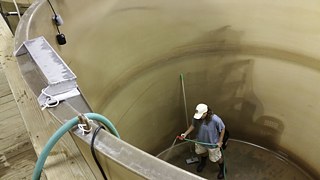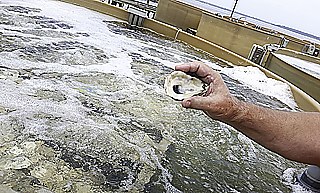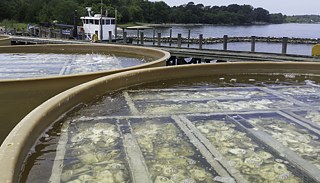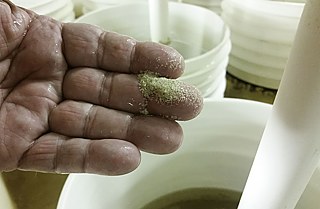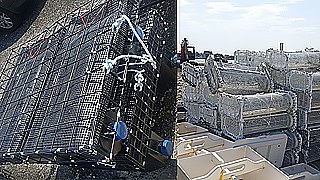Food
Oyster Farming
Businesses and towns were built and thrived based on its surrounding waterways.
Aquaculture is gaining rock star status in foodie circles; you can jump on in the deep end or shallow end! Oyster farming or oyster gardening for those who have dock space is the most delicious way to help clean the Chesapeake Bay.
Mature oysters spawn when water temperatures and salinity levels are good; hatcheries can create these proper conditions. The larvae that are produced from this spawning can be sorted and shipped to oyster farmers after they grow to an ideal size and development stage. “Eyed” oyster larvae (named for the eye-spot they develop at this size) are considered to be at the proper size for easy shipping and introduction into a farming operation that has the ability to
set their own seed. For oyster farmers who don’t have a good location for setting their own seed due to cost or location, hatcheries and nurseries offer “seed” or “spat on shell” clutched (seeds on a larger substrate like an old oyster shell) or cultch-less (tiny cultch sized similar to the eyed larvae). Your setting and grow-out choices will be dictated by whether you grow in the ground of a tidal waterway, or in the water column.
A lot of care and work take place at hatcheries prior to eyed oyster larvae being shipped to farmers. Good hatcheries make sure eggs and sperm are introduced in proper environments. They examine and sort the newly formed oyster larvae while being fed a constant supply of circulated water and food. Algae, the larvae’s food source, is nutrient rich and hatcheries and nurseries make sure to increase feeding during stressful growth times in order to maximize larvae production and produce more healthy and hardy larvae.
Shipments of eyed oyster larvae, received by farmers with nursery space and equipment, arrive in small packages usually weighing under two pounds. These larvae resemble piles of wet mud or sand. Once eyed oyster larvae are received, the next steps a farmer follows depend on their operational set-up, goals and available aquaculture.
Oysters can be matured in various ways. In Maryland, most maturity (grow-out) takes place above ground in the water column using matured cultch-less spat. Matured seed/spat on shell are not used often since ground seeding is not commonly an environmentally available option. If bottom growing were viable for the oyster farmer, the seed/spat on shell could be created by introducing eyed larvae to a tank of cultch, or the farmer could simply purchase the spat on shell.
The most commonly purchased spat/seed from hatcheries in Maryland is cultch-less spat, or micro-cultch seed. By implementing the use of a downweller, this spat/seed can be grown if the farmer has the space, equipment and budget.
Downwellers do not require much space. They push re-circulated water and nutrients
downward towards the larvae and the tiny cultch so they can bond into a spat/seed (hence the term downweller). Usually only one larvae can attach itself to a similarly sized micro-cultch.
Once these smaller oyster spat/seed are created in the downwellers they can be moved to upwellers, for growth, sorting and monitoring. Upwellers circulate water and algae upward (hence the term upweller) for the young, tiny oyster seed to feed and grow until planting. To further increase speed of growth and volume of seed, floating upwellers built to float on open water can be utilized in conjunction with other types of upwellers until seed is ready for planting. The best thing about floating upwellers (FLUPSY’S) is that they can easily increase water flow volume because they are partially submerged in the water column, moving water laterally instead of upward. This increased volume of water flow brings in more nutrients to oysters at a faster rate and volume. These upwellers also provide multiple areas to sort and house oysters at varying growth stages until they leave for grow-out. Floating upwellers and upwellers in general are great for an oyster farmers’ work flow and production.
When oyster seed reach a healthy intermediate age and size for grow-out, they are ready to leave the nursery to be “planted” in one of several ways: in open water on the ground, in floating cages or in suspended bags. These are checked and sorted for harvest according to the season, location and many other varying factors depending on the farmers location, grow-out style and market. Oysters are typically ready for harvest between eighteen and twenty-seven months.
The next time you are enjoying a fresh local oyster you will have the pleasure of knowing you are helping local businesses, as well as preserving the history of aquaculture, assisting other species and cleaning your waterways, Wow! Oyster farming is now such a satisfying and worthwhile pursuit.
I would like to thank everyone for their time and information at: University of Maryland Center for Environmental Science, Horn Point Oyster Hatchery, and Hooper's Island Oyster Aquaculture Company.




